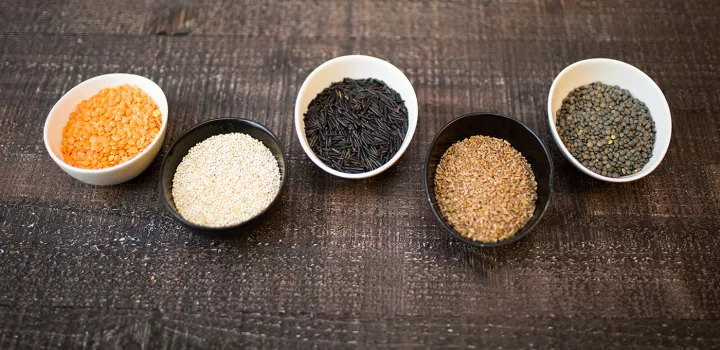
Why Should We Eat Whole Foods?
Natural Gourmet Institute founder Annemarie Colbin Ph.D. was celebrated for her teachings on food, science and nutrition, which are now more prominent than ever in the better food movement.
Annemarie was a true visionary: inquisitive, intuitive, relentless, progressive and thoughtful. In the late 1970s, she recovered important facts about food – namely, that what we eat directly impacts our well-being, our communities and our planet. Here’s how she described the importance of eating whole foods and how they provide the nutrients that our bodies need.

This article was written by Natural Gourmet Institute founder, Annemarie Colbin Ph.D. for Free Spirit Magazine’s December-January 1998-1999 issue.
For many years I have been teaching that it is a good idea to consume whole foods for our health and well-being. The reasons seem obvious. Whole foods are those that nature provides with all their edible parts.
Whole foods of vegetable origin include fresh vegetables and fruits, whole grains (millet, brown rice, oats, rye, whole wheat, buckwheat, quinoa, cornmeal), beans and legumes (lentils, chickpeas, kidney beans), and nuts and seeds. Whole foods of animal origin include eggs, seafood, etc. Eating whole foods ensures consumption of the maximum amount of original nutrients in the right proportions.
Conversely, fragmented foods include all foods that are missing original parts. Refined complex carbohydrates such as white flour and white rice are missing fiber and nutrients found in bran and germ. Sweeteners like crystalized sugars, syrups and concentrates are all missing water and some nutrients. Refined and deodorized oils and fats are missing their trace elements, as well as the rest of the plant or animal from which they come. Fragmented foods that have generally been considered healthful include juices and tofu (all missing fiber), bran, wheat germ (missing starch) and vitamin supplements (missing macro nutrients).
A healthful regime would include at least 70-80% whole foods. For a long time, society ignored the idea that we are programmed to survive on what the earth provides, even though studies had shown conclusively that various fragmented foods contributed to disease, such as polished rice causing beri-beri and both B-vitamin deficiencies.
But there have been some studies that show more clearly that the body can distinguish between whole and fragmented foods, between whole foods and nutrients taken in forms of supplements, and that whole foods have better health benefits than the individual nutrients.
For example, whole foods are more likely to protect against disease than their individual nutrients. According to Nan Kathryn Fuchs, Ph.D. in the September 1998 Women’s HealthLetter, whole grains give better protection against chronic diseases than any other component nutrients used as supplements. One of the major benefits of eating whole grains is that they slow down the digestive process, thereby allowing better absorption of the nutrients. Their fiber content also regulates blood sugar by slowing down the conversion of starches into glucose. Whole grains make favorable changes in the intestines, allowing healthful bacteria to keep disease-producing bacteria in check; they have strong antioxidant properties to help protect the body against free radicals as well as phytoestrogens and phytochemicals that break down carcinogenic substances. And grains have a more concentrated amount of these phytochemicals than fruits and vegetables.
Apparently, we don’t need much: a half cup of brown rice, a bowl of oatmeal or a few slices of wholegrain bread may be quite sufficient. Here is a reminder of which grains are whole, in addition to those mentioned: consider whole-grain rye, barley, quinoa, amaranth, whole wheat, buckwheat or kasha, millett, and whole corn or non-degermed cornmeal. Foods that are not whole-grain are regular pasta, breakfast cereals (unless specifically made from whole grains), most breads (look for wheat in the ingredient list, and you’ll know it contains white flour), white rice and degermed cornmeal.
Ensuring our nutritional health is therefore quite simple. We do so by consuming one to two servings of whole grains daily, a serving of beans and/or animal protein, plenty of vegetables of many different colors, and fruit and nuts as snacks.
Learn more about whole foods in Health-Supportive Culinary Arts.
Sources: Fuchs, Nan Kathryn, PH.D., in The Nutrition Detective: Healthy Whole Grains, quoting from J. Slavin; D. Jacobs and L. Marquart, “Whole-Grain Consumption and Chronic Disease: Protective Mechanisms.” Nutritional Cancer, 1997.


Add new comment